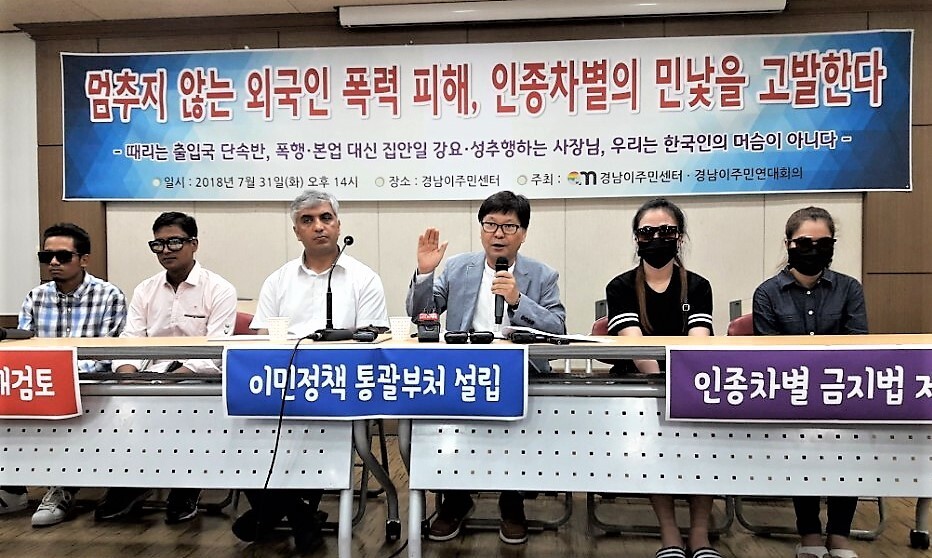hankyoreh
Links to other country sites 다른 나라 사이트 링크
Female migrant workers encounter difficulties in reporting sexual harassment

“K,” a female migrant worker employed on a farm, filed a report with the local employment and labor office in Chungju in March 2018 accusing the business’s owner of sexual harassment. The owner patted K’s buttocks several times and sent sexually harassing text messages to her mobile phone.
Fed up with the treatment, K finally applied for a change of workplace and was able to relocate immediately to another environment – but the business owner responsible for the harassment was only punished with a fine.
Instances of migrant workers like K demonstrating the courage to report sexual harassment against them are extremely rare.
According to data received from the Ministry of Employment and Labor (MOEL) on Oct. 3 by the office of Liberty Korea Party lawmaker Moon Jin-kook, a total of just 19 reports of workplace sexual harassment (involving 22 victims) were received by the ministry from migrant workers in the five years between 2013 and July 2018. As of July 2018, just over 17,000 female migrant workers were employed in South Korea. The number rises to 24,000 when Ministry of Justice estimates of undocumented workers are factored in.
The reason migrant workers are so fearful of reporting sexual abuse is the worry they could end up deported as illegal sojourners. The language barrier and a lack of information are also major factors. The current employment permit system only allows migrant workers to change workplaces under exceptional circumstances.
For a worker to change workplaces for reasons of sexual harassment, the abuses must be proven. While the government recently announced plans to introduce an “emergency workplace alteration system” to allow migrant workers reporting workplace sexual harassment to change workplaces before an investigation takes place, migrant worker human rights groups remain skeptical.
“Proving sexual harassment is difficult even for South Korean citizens,” said Women Migrants’ Human Rights Center representative Heo-Oh Young-sook.
“How many migrant workers will take the risk of reporting when they could end up failing to prove [harassment] and having to return home, or having to continue working alongside the person they reported?” she asked.
Of the 19 sexual harassment cases reported to MOEL over the five-year period, only around half of them – ten total – ended with the business owner or South Korean co-worker responsible being referred with a recommendation for indictment. Apart from one case in which a fellow migrant worker was arrested as the perpetrator, the other eight cases were resolved with the business owner receiving a fine and the victim transferring to a different workplace.
It’s a situation where perpetrators are not properly punished even when migrant workers make active efforts to share their abuses. In 15 of the 19 cases, the perpetrators were business owners.
Other survey findings confirm that female migrant workers are not relying on MOEL, which is seen as passive in its response. A ministry survey of 1,000 migrant workers in the area of agriculture in Mar. 2017 showed only five (0.5 percent) reporting experiences with sexual harassment or assault. In contrast, a 2016 survey of human rights conditions for female migrant workers in manufacturing by the National Human Rights Commission of Korea showed 45 out of 385 respondents, or 11.7 percent, answering that they had experienced sexual harassment or assault.
By Lee Ji-hae, staff reporter
Please direct comments or questions to [english@hani.co.kr]

Editorial・opinion
![[Column] Has Korea, too, crossed the Rubicon on China? [Column] Has Korea, too, crossed the Rubicon on China?](https://flexible.img.hani.co.kr/flexible/normal/500/300/imgdb/original/2024/0419/9317135153409185.jpg) [Column] Has Korea, too, crossed the Rubicon on China?
[Column] Has Korea, too, crossed the Rubicon on China?![[Correspondent’s column] In Japan’s alliance with US, echoes of its past alliances with UK [Correspondent’s column] In Japan’s alliance with US, echoes of its past alliances with UK](https://flexible.img.hani.co.kr/flexible/normal/500/300/imgdb/original/2024/0419/2317135166563519.jpg) [Correspondent’s column] In Japan’s alliance with US, echoes of its past alliances with UK
[Correspondent’s column] In Japan’s alliance with US, echoes of its past alliances with UK- [Editorial] Does Yoon think the Korean public is wrong?
- [Editorial] As it bolsters its alliance with US, Japan must be accountable for past
- [Guest essay] Amending the Constitution is Yoon’s key to leaving office in public’s good graces
- [Editorial] 10 years on, lessons of Sewol tragedy must never be forgotten
- [Column] A death blow to Korea’s prosecutor politics
- [Correspondent’s column] The US and the end of Japanese pacifism
- [Guest essay] How Korea turned its trainee doctors into monsters
- [Guest essay] As someone who helped forge Seoul-Moscow ties, their status today troubles me
Most viewed articles
- 1[Column] The clock is ticking for Korea’s first lady
- 2After 2 months of delayed, denied medical care, Koreans worry worst may be yet to come
- 3Hong Se-hwa, voice for tolerance whose memoir of exile touched a chord, dies at 76
- 4Samsung barricades office as unionized workers strike for better conditions
- 5[Column] Has Korea, too, crossed the Rubicon on China?
- 6US overtakes China as Korea’s top export market, prompting trade sanction jitters
- 7[Editorial] As it bolsters its alliance with US, Japan must be accountable for past
- 8[Correspondent’s column] In Japan’s alliance with US, echoes of its past alliances with UK
- 9All eyes on Xiaomi after it pulls off EV that Apple couldn’t
- 10[Guest essay] How Korea turned its trainee doctors into monsters